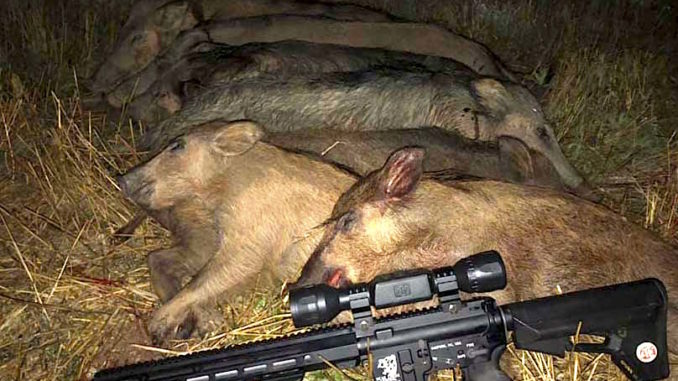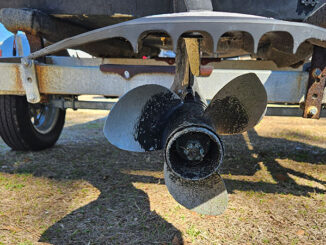
Find these four food sources, and you’ll stack up wild hogs
Have you ever seen those large piles of hogs stacked up on social media and wondered how those hunters accomplish such an impressive pile? The average hunter believes it is available land or some overpopulated portion of the state overrun by hogs.
What it really comes down to is a hot food source that brings hogs from miles around. At certain times of the year, hogs know about a wonderful food source and they will group up like stripers or crappie and make those large stacks of harvested animals possible. Let’s take a look at four food sources that draw hogs in and how you can capitalize on them.
Wheat
A local farmer messaged me to tell me he had run a harvester through a field of wheat and seen fresh hog damage. The farmer decided the wheat was still too wet and put off full harvest for the week but that message sent me into immediate action.
Just after sunset I arrived and put eight hogs on the ground before midnight, dropping seven of the first in a group of nine. Farmers know the prime time to harvest their crops and so do the hogs in the area. Hogs will return and change times to avoid hunters. So switch your times up and stay on hogs as long as the food source produces. The next trip I make to this area, I will arrive in the midnight to 2 a.m. time frame and find more targets.
June in the Carolinas means wheat harvest and large piles of hogs. Knowing the crops in your area as well as keying in on landowner’s scouting can put you on areas that draw hogs from miles.
Also, remember the pattern each year and get on the group early. I file my harvest pictures in a way where I know the dates from previous years and make a trip or call to that landowner. Hot food sources can produce each and every year.
Mast crop
Acorn crops can make or brake a hunter’s season. Finding the hot area of mast crop can be done in a few ways. Old school is putting miles on your boots scouting, traveling miles on foot to find the high producing trees with plenty of sign.
Another way is again to listen to landowners that travel their land daily and find sign. With hogs, sign can be easily seen. Many landowners have put me on large numbers of hogs by seeing this sign while maintaining fencelines or cutting fields.
I also use technology to find these areas. I scan old large oak areas with a thermal scanner. If I find an area that is holding numbers of any animal due to mast crop falling, I will note this area as a possible hog feeding area. I often find particular oaks that have a large group of deer that frequent under them. This will also attract hogs, but during later hours. The deer point me toward the hot food sources that bring hogs later. Some oaks fall early (water oaks, pin oaks) while others go until the New Year. So these areas can change annually. September to December is great for this hot food source.
Rooting
The sign that gets the most attention is rooting. Landowners do not want to put up with the large rooting areas on their land. While driving farm equipment over these areas, signs of rooting gets their attention immediately and they will make the call to you.
Keep track of the times of year when the rooting occurs. There are certain seeds in the ground that hogs love and they return every year to get these treats. I constantly check these areas as I drive through to find the right time the hogs feed there.
Distance from the hogs’ bedding areas determine their times of feeding there. Thick, close areas can mean early feed times. Wide open, large fields would point more toward middle of the night areas. Key in on this hot food source to stack hogs in your area.
Rain brings softer ground, which often increases rooting. Another hot tip is a summer rooting area. For hogs to root an area during the summer, this spot should be remembered because most ground is harder due to lack of rain and rooting areas at this time will be hit every summer. Rain rooting is much more spread out as all ground is softer.
Livestock feeding areas
During winter, vegetation growth is at it’s lowest and farmers are transporting cut bales to their herds of livestock. These are great times for landowners to notice rooting on this food source.
If you have ever seen a farmer delivering food to his animals, those animals all know the truck and come running. The hogs in the area know too, and from January to April, these areas where farmers feed their herds can be hot for the wild hogs. Landowners have called and put me on this pattern many times. Every few days the owner is driving on the land and can tell you when the sign is fresh. When you get the call, make plans to spend some time in those areas.
Big hog stacks are possible on many properties, we must be able to watch for the sign and capitalize on those hot food sources when they produce.
Find more hog and coyote hunting tips at GOAT Productions.




Be the first to comment